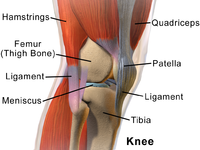
Photo from wikipedia
Background: Overweight is a major risk factor for the development and progression of knee osteoarthritis (OA). Weight loss for patients with knee OA has been associated with improvement in self-reported… Click to show full abstract
Background: Overweight is a major risk factor for the development and progression of knee osteoarthritis (OA). Weight loss for patients with knee OA has been associated with improvement in self-reported pain and function and is recommended by EULAR as part of the therapeutic management. Objectives: The aim of the study was to evaluate the relation between overweight and functional impairment in adults with knee OA. Methods: It was a prospective study conducted in a rheumatologic department over a 4 months period. Patients with symptomatic knee OA based on the ACR criteria, were included. A screening of body mass index (BMI) was carried out for all patients. It was categorized following the WHO classification into: normal ( Pain level was evaluated using the Visual Analogue Scale (VAS). Function was assessed by the short form of the Knee injury and Osteoarthritis Outcome Score (KOOS-PS) (KOOS-PS scores to 0 representing no difficulty and 100 representing extreme difficulty). The patients’ knee radiographies were graded according to Kellgren Lawrence criteria (KL). The patients were allocated in two groups; as grade I-II KL (Group 1) and grade III-IV KL (Group 2). Results: We included 143 patients with a mean age of 65.17± 10.7 years and 88.1% of women. Patients were from low socio-economic class in 30.8% of cases. Mean disease duration of the KOA was 5.4 years [3months-20 years] and mean BMI was 31.8±5.6kg/m2. Patients were with normal weight in 16.1%, overweight in 19.6% and obese in 64.3%. Knee OA was bilateral in 85.3% and other OA sites were associated in 37.8% of patients. Mean VAS pain of knee OA was 6.6±1.5 and KOOS-PS was 48.8±16.5/100. Concerning the radiographic damage; we found grade I-II (KL) in 22.6% and grade III-IV (KL) in 77.4%. High BMI (BMI≥25 kg/m2 was not significantly associated with worse KOOS score (p=0.9), more pain (p=0.5) or an increasing severity of radiological knee osteoarthritis (p=0.14). Moreover, the level BMI was not associated with the presence of other OA sites (p=0.9) or a bilateral KOA (p=0.07). Conclusion: These data, from a subset of participants with symptomatic radiographic knee OA, demonstrate no correlation between obesity and pain, functional impairment and radiographic severity. Acknowledgments: none Disclosure of Interests: None declared
Journal Title: Annals of the Rheumatic Diseases
Year Published: 2020
Link to full text (if available)
Share on Social Media: Sign Up to like & get
recommendations!